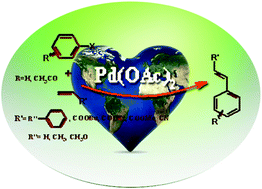Pd(OAc)2 without added ligand as an active catalyst for Mizoroki–Heck reaction in aqueous media†
Abstract
Conditions for an efficient

* Corresponding authors
a
Department of Chemistry, Faculty of Science, University of Maragheh, Golshahr, P.O. Box: 55181-83111731, Maragheh, Iran
E-mail:
mamini@maragheh.ac.ir
Fax: +98 421 2276066
Tel: +98 421 2278900
b Chemistry Department, Sharif University of Technology, PO Box 11155-3516, Tehran, Iran
Conditions for an efficient

 Please wait while we load your content...
Something went wrong. Try again?
Please wait while we load your content...
Something went wrong. Try again?
M. Amini, M. Bagherzadeh, Z. Moradi-Shoeili and D. M. Boghaei, RSC Adv., 2012, 2, 12091 DOI: 10.1039/C2RA21459H
To request permission to reproduce material from this article, please go to the Copyright Clearance Center request page.
If you are an author contributing to an RSC publication, you do not need to request permission provided correct acknowledgement is given.
If you are the author of this article, you do not need to request permission to reproduce figures and diagrams provided correct acknowledgement is given. If you want to reproduce the whole article in a third-party publication (excluding your thesis/dissertation for which permission is not required) please go to the Copyright Clearance Center request page.
Read more about how to correctly acknowledge RSC content.
 Fetching data from CrossRef.
Fetching data from CrossRef.
This may take some time to load.
Loading related content
